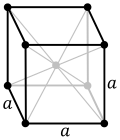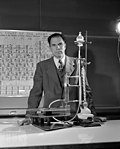Seaborgium
Seaborgium is a chemical element. In the past, it has been named eka-tungsten but is now named seaborgium. It has the symbol Sg and it has the atomic number 106. Seaborgium is a radioactive element that does not exist in nature. It has to be made. The most stable isotope is 271Sg. Seaborgium-271 has a half-life of 2.4 minutes.
| General properties | |||||||||||||||||||||||||||||||||||
|---|---|---|---|---|---|---|---|---|---|---|---|---|---|---|---|---|---|---|---|---|---|---|---|---|---|---|---|---|---|---|---|---|---|---|---|
| Pronunciation | /siːˈbɔːrɡiəm/ ( | ||||||||||||||||||||||||||||||||||
| Mass number | 269 (most stable isotope) | ||||||||||||||||||||||||||||||||||
| Seaborgium in the periodic table | |||||||||||||||||||||||||||||||||||
| |||||||||||||||||||||||||||||||||||
| Atomic number (Z) | 106 | ||||||||||||||||||||||||||||||||||
| Group | group 6 | ||||||||||||||||||||||||||||||||||
| Period | period 7 | ||||||||||||||||||||||||||||||||||
| Block | d-block | ||||||||||||||||||||||||||||||||||
| Element category | transition metal | ||||||||||||||||||||||||||||||||||
| Electron configuration | [Rn] 5f14 6d4 7s2[1] | ||||||||||||||||||||||||||||||||||
Electrons per shell | 2, 8, 18, 32, 32, 12, 2 | ||||||||||||||||||||||||||||||||||
| Physical properties | |||||||||||||||||||||||||||||||||||
| Phase at STP | Sg: Unknown phase (predicted)[2] | ||||||||||||||||||||||||||||||||||
| Density (near r.t.) | 35.0 g/cm3 (predicted)[1][3] | ||||||||||||||||||||||||||||||||||
| Atomic properties | |||||||||||||||||||||||||||||||||||
| Oxidation states | 0, (+3), (+4), (+5), +6[1][3] (parenthesized: prediction) | ||||||||||||||||||||||||||||||||||
| Ionization energies | |||||||||||||||||||||||||||||||||||
| Atomic radius | empirical: 132 pm (predicted)[1] | ||||||||||||||||||||||||||||||||||
| Covalent radius | 143 pm (estimated)[4] | ||||||||||||||||||||||||||||||||||
| Other properties | |||||||||||||||||||||||||||||||||||
| Natural occurrence | Sg: Synthetic | ||||||||||||||||||||||||||||||||||
| Crystal structure | body-centered cubic (bcc) (predicted)[2] | ||||||||||||||||||||||||||||||||||
| CAS Number | 54038-81-2 | ||||||||||||||||||||||||||||||||||
| History | |||||||||||||||||||||||||||||||||||
| Naming | after Glenn T. Seaborg | ||||||||||||||||||||||||||||||||||
| Discovery | Lawrence Berkeley National Laboratory (1974) | ||||||||||||||||||||||||||||||||||
| Main isotopes of seaborgium | |||||||||||||||||||||||||||||||||||
| |||||||||||||||||||||||||||||||||||
What Seaborgium looks like is not known because not enough has been made to see it with human eyesight, but since it is in the same period as tungsten in the periodic table, its appearance and may be similar to it.
The element is named in honor of Glenn Seaborg.
Seaborgium is a transuranium element. This means that it is "beyond" (trans) the element Uranium in the sequence of elements.
Mendeleev predicted that Seaborgium would exist. He called the element eka-tungsten because of its location was near Tungsten in the Periodic Table. The chemistry of seaborgium is like the chemistry of tungsten.
Uses
Seaborgium has no uses at all because of how fast it destroys itself.
Chemistry
Seaborgium hexacarbonyl Sg(CO)
6 was made using the same method as tungsten hexacarbonyl and molybdenum hexacarbonyl. Its only known and studied as a gas.[6]
Seaborgium Media
Element 106 was named after Glenn T. Seaborg, a pioneer in the discovery of synthetic elements, with the name seaborgium (Sg).
Sources
- ↑ 1.0 1.1 1.2 1.3 1.4 1.5 Hoffman, Darleane C.; Lee, Diana M.; Pershina, Valeria (2006). "Transactinides and the future elements". In Morss; Edelstein, Norman M.; Fuger, Jean (eds.). The Chemistry of the Actinide and Transactinide Elements (3rd ed.). Dordrecht, The Netherlands: Springer Science+Business Media. ISBN 1-4020-3555-1.
- ↑ 2.0 2.1 Östlin, A.; Vitos, L. (2011). "First-principles calculation of the structural stability of 6d transition metals". Physical Review B. 84 (11). Bibcode:2011PhRvB..84k3104O. doi:10.1103/PhysRevB.84.113104.
- ↑ 3.0 3.1 Fricke, Burkhard (1975). "Superheavy elements: a prediction of their chemical and physical properties". Recent Impact of Physics on Inorganic Chemistry. 21: 89–144. doi:10.1007/BFb0116498. Retrieved 4 October 2013.
- ↑ "Periodic Table, Seaborgium". Royal Chemical Society. Retrieved 20 February 2017.
- ↑ Utyonkov, V. K.; Brewer, N. T.; Oganessian, Yu. Ts.; Rykaczewski, K. P.; Abdullin, F. Sh.; Dimitriev, S. N.; Grzywacz, R. K.; Itkis, M. G.; Miernik, K.; Polyakov, A. N.; Roberto, J. B.; Sagaidak, R. N.; Shirokovsky, I. V.; Shumeiko, M. V.; Tsyganov, Yu. S.; Voinov, A. A.; Subbotin, V. G.; Sukhov, A. M.; Karpov, A. V.; Popeko, A. G.; Sabel'nikov, A. V.; Svirikhin, A. I.; Vostokin, G. K.; Hamilton, J. H.; Kovrinzhykh, N. D.; Schlattauer, L.; Stoyer, M. A.; Gan, Z.; Huang, W. X.; Ma, L. (30 January 2018). "Neutron-deficient superheavy nuclei obtained in the 240Pu+48Ca reaction". Physical Review C. 97 (14320): 1–10. Bibcode:2018PhRvC..97a4320U. doi:10.1103/PhysRevC.97.014320.
- ↑ Even, J.; et al. (2014). "Synthesis and detection of a seaborgium carbonyl complex". Science. 345 (6203): 1491–1493. Bibcode:2014Sci...345.1491E. doi:10.1126/science.1255720. PMID 25237098.
Other websites
| Wikimedia Commons has media related to Lua error in Module:Commons_link at line 62: attempt to index field 'wikibase' (a nil value).. |



